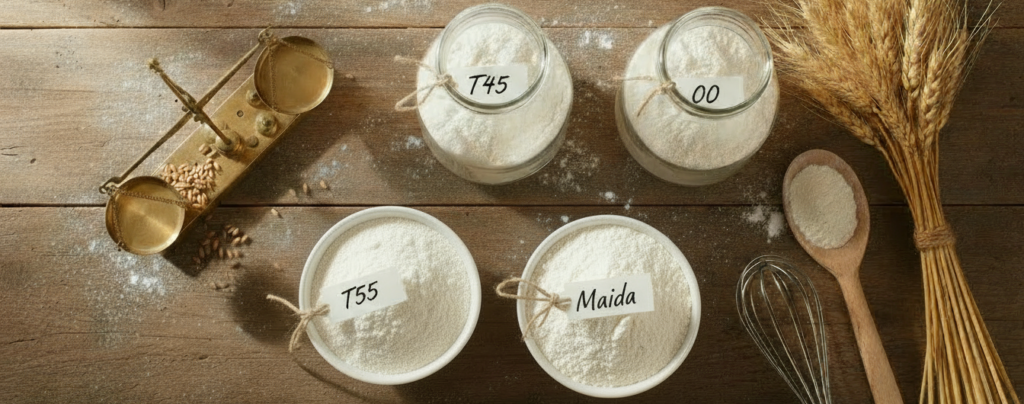Types of Flour Explained: What T45, T55, and 00 Actually Mean

You’ve probably seen them on packaging or recipe blogs — T45, T55, T65, T150, 00, 0, 1…
Looks like a secret bakery code, right? Don’t worry — you’re not alone. Most bakers start off thinking these are just fancy European ways to say flour.
But here’s the fun part: those mysterious “T” and “00” labels actually tell you how your flour behaves — how it feels, bakes, browns, and even how your bread will rise.
Let’s decode them, the TWF way 👇
1. The “T” Series — French Precision in Every Gram
The “T” in T45, T55, T65, etc. stands for “Type”, and the number indicates the ash content — a measure of how much mineral or bran is left after milling.
Think of it like a spectrum from pure white to earthy wholegrain.
| Flour Type | Ash Content | Texture | Best for |
T45 | ~0.45% | Very soft, fine | Cakes, croissants, pastries |
T55 | ~0.55% | Balanced strength | Breads, pizza, puff pastry |
T65 | ~0.65% | Slightly coarser, more flavor | Rustic breads, sourdough |
T150 | ~1.50% | Wholegrain, dense | Whole wheat breads |
In TWF terms:
- T45 → Crafted for precision bakes and delicate crumb.
- T55 → The all-rounder — balanced strength and softness.
- T65+ → For bakers chasing nutrition, flavor, and artisanal texture.
So when you’re holding a TWF T55 Bread Flour, you’re holding the sweet spot — balanced gluten strength, soft crumb, and just enough minerals to give your bread that authentic French texture.
2. The Italian Grades — The Legendary “00” Flour
Italy keeps it sleek — 00, 0, 1, 2.
The fewer the zeros, the finer the grind.
| Flour Type | Texture | Best For |
| 00 | Ultra-fine, silky soft | Silky pizza doughs, thin-crust Neapolitan pie |
| 0 | Fine, lightly grainy | Focaccia, ciabatta |
| 1 | Medium coarse, close to wholegrain | Rustic breads, high-fiber loaves |
| 2 | Coarse, bran-rich | Dense, hearty wholegrain loaves |
- 00: Ultra-refined, powdery soft. Think silky pizza doughs and thin-crust Neapolitan pies.
- 0: Slightly stronger, perfect for focaccia or ciabatta.
- 1 & 2: Closer to wholegrain, used for rustic or high-fiber loaves.
At TWF, our Neapolitan 00 Pizza Flour and Thin Crust Pizza Flour capture this style — milled fine, low in bran, high in finesse.
3. The Everyday “All-Purpose (TWF First Flush APF)” and “Maida”
Closer to home, we use simpler terms — Maida or All-Purpose Flour.
But these don’t always mean the same thing.
| Flour Type | Texture | Color | Gluten Strength | Best For |
First Flush APF (All- Purpose) | Ultra-fine, soft, and light | Creamy white | Low — delicate structure | Pastries, biscuits, samosas, bhaturas |
Maida | Slightly coarser, smooth balance | Creamy white | Moderate — ideal for baking | Breads, cookies, pizzas, muffins |
- All-Purpose Flour: Refined — it keeps a little of the wheat’s natural goodness and slightly more nutritious with a Mildly wheaty, fuller flavor.
- Maida: Super-refined — the bran (outer layer) and germ (the nutritious part) are completely removed and has a neutral and subtle flavor.
If you’ve used our TWF First Flush APF (All-Purpose) , you’ve met the Indian cousin of French T55 — versatile, consistent, and made for scale.
4. The Unsung Heroes — Atta, Wholegrain & Specialty Flours
And then comes the Heritage Grains — where TWF also shines.
Terms like Sharbati, Khapli, or Sail might sound traditional, but they hold the future of mindful eating.
These aren’t coded by ash or type — they’re defined by origin, milling technique, and nutrient retention.
Our Multi-Dimensional Milling™ process ensures that each grain — whether Khapli or Highland Sharbati — retains up to 9X more nutrients with 3.4x more Protein than regular atta.
So, Why Does It Matter?
Because flour isn’t just powder. It’s the foundation of texture, flavor, and nutrition.
Choosing the right type can mean the difference between a chewy baguette and a dense loaf — between a flaky croissant and a heavy pastry.
And now that you know what those fancy names mean — you’ll never look at your flour shelf the same way again.


Noice!!!